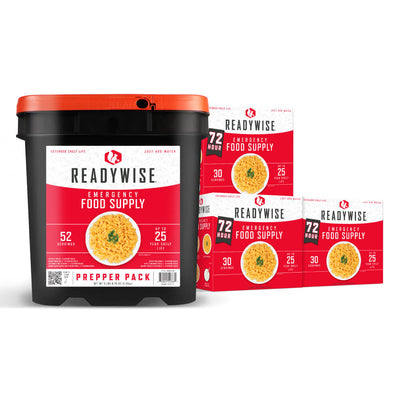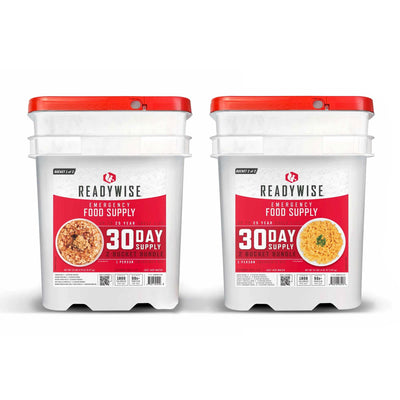How to Survive in Insane Heat and in Unbearable Cold
Extreme weather can turn a camping trip or hike into a serious emergency. Both high heat and extreme cold are life-threatening, and need to be taken seriously. As with almost all emergencies, a little planning and the right gear makes all the difference when confronting dangerous temperatures.
How to Survive in Heat
When the temperature soars, dehydration, heat exhaustion, and heat stroke become your worst enemies, and water your best friend. If you know you’re going to encounter high temperatures, plan to drink a quart of water in the morning, at every meal, and before engaging in physical activity. As a general rule this factors out to about a quart an hour, depending on your size and the temperature.
That advice translates into a large amount of water, which is fine if you’re combatting extreme temperatures near a reliable water source, but less so if you’re hiking the back country. Before setting out into any area where water scarcity is a possibility, ask about water sources on your route, whether the source could have dried up, and how safe it is. Adding a water purification device to your backpack can protect you from waterborne infection in a pinch, although you’re better off boiling water from natural sources for at least ten minutes.
Drink often, in small amounts. Gulping down a large amount of liquid can cause heat cramps. It’s best to drink cool water rather than warm or ice cold, so keep your water out of the sun, wrapping it in damp clothing if possible.
Eat regular meals. Food helps replenish your body’s salt levels and keeps your electrolytes balanced. Too little salt can lead to heat cramps, while a combination of dehydration and low salt levels causes heat exhaustion.
If traveling in extreme heat, take a cue from desert cultures and only travel during the coolest parts of the day—the early morning and late evening. Between these times seek out shade and rest. In situations where natural shade is limited, a camping tarp can help you make your own.
The right choice of clothing can help you survive high temperatures. Choose lightweight garments that cover as much skin as possible, including a broad hat to protect your face and neck. Use sunscreen on any exposed skin if you have some.
Tempting though it might be, do not remove clothing. Exposing bare skin to high temperatures increases sweating and moisture loss (not to mention risking a serious sunburn, which also causes dehydration). Clothing traps sweat and helps cool the body. Be aware as well that a combination of high temperature and low humidity causes sweat to evaporate so fast you might not realize you’re sweating at all.
How to Survive in Cold Conditions
Extreme cold carries different, but no less serious risks. In such situations, frostbite and hypothermic are your enemies, and become an issue in temperatures as mild as 50 Fahrenheit, especially in wet and windy conditions.
Hypothermia requires you to find warmth as quickly as possible. If shelter isn’t available, you’ll have to make your own (see our blog on wilderness shelters for shelter ideas). Make shelters as small as possible, to slow the loss of body heat to the surrounding environment.
Cover yourself with dry blankets, sleeping bags—anything to keep your body warmth as contained as possible. Even newspaper provides some small degree of protection from the elements. If you’re with other people, share sleeping bags and maintain close body contact for warmth.
Be aware that if someone in your party is suffering from hypothermia, they need to be kept as horizontal and calm as possible, as hypothermia victims are at risk of cardiac arrest.
The clothes you wear into cold environments are extremely important:
- Layer loose-fitting clothing and headgear so you can add or remove items to regulate temperature.
- Keep clothing as clean as possible—dirt and moisture seal the air spaces within layers, reducing air circulation and warmth.
- Remove layers to avoid overheating. Sweating causes moisture that seeps into clothes, chilling rather than warming you.
- Avoid tight clothing, which reduces the body’s ability to warm itself through blood circulation.
- Layer feet with multiple layers of socks, removing and replacing wet socks.
- Mittens are warmer than gloves, as the fingers are in contact with each other.
- Your parka should be made with goose down or similar materials, and be large enough to accommodate multiple layers of clothing.
Moist and wet clothes represent a serious danger, and should be replaced as soon as possible. If you can, sleep in a different and dry set of clothes to the ones you wore during the day. Naked and dry in a sleeping bag is preferable to sleeping in damp clothes in cold environments.
As with hot temperatures, you need to stay hydrated. Dehydration will make you sluggish and more susceptible to hypothermia. At extremely cold temperatures your thirst response is compromised, so drink regularly even if you don’t feel thirsty.
Do not eat snow—doing so lowers your core temperature. Melt and boil snow if possible. If not, wrap snow in a piece of clothing and suck the melted snow out of the cloth. Avoid alcohol and caffeine as well—they provide a brief feeling of warmth, but contribute to dehydration.
A fire can mean the difference between life and death in cold conditions. If you have a shelter, position the fire in front of the entrance (be sure the wind isn’t going to blow smoke into your shelter). Dry animal dung and shaved pieces of bark make excellent kindling.
Placing large rocks around the fire doesn’t just contain the flames. Once heated, rocks can be rolled into your shelter for extra warmth. Be careful moving them, of course. You’re in a serious enough situation without burning yourself.
With preparation, common sense, and a little know how, it’s possible to survive in extreme temperatures. One final note though. Knowing when to call off a trip based on the weather can prevent ever having to learn how to survive in heat and cold. It may ruin the weekend hike, but it won’t ruin your life.
Resources
http://survival.about.com/od/10/a/How-To-Survive-Extreme-Heat.htm
http://adventure.howstuffworks.com/how-to-survive-the-freezing-cold.htm
http://www.wilderness-survival.net/natural-hazards/extreme-heat/
















































































